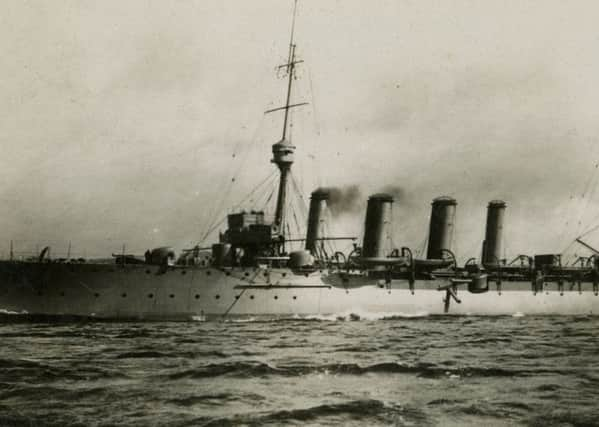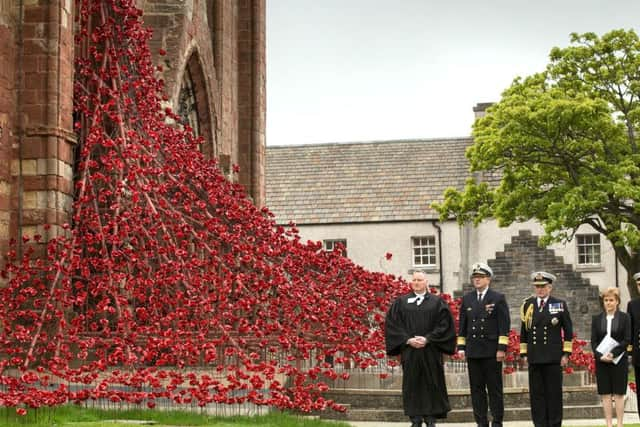First World War wreck off Yorkshire's coast brought back to life


A century ago, bystanders watching from the shore at Skipsea could have seen HMS Falmouth slip into the icy depths of the North Sea - another victim of the German U-boats.
It was a sad end for the British warship which had fought in the Battle of Jutland - the biggest naval conflict of the First World War - earlier that summer in 1916, only to be torpedoed on August 20.
Advertisement
Hide AdAdvertisement
Hide AdFor a hundred years the wreckage lay on the seabed just a few miles off the Yorkshire coast in a forgotten, watery grave. But now, to mark the centenary of its sinking, HMS Falmouth has been brought back to life.


The heritage agency Historic England used 3D technology and a new seabed survey of the wreck to recreate the ship in its final resting place and revive the memory of a piece of wartime heritage that had been lost beneath the waves.
This seabed survey of the site, the only substantial wreck of a Royal Navy warship which fought in the Battle of Jutland now lying in English waters, was carried out with help from the Maritime and Coastguard Agency.
The results were then combined with a digital image of a builder’s model of HMS Falmouth, held by the Imperial War Museum at Chatham Historic Dockyard, to produce the 3D image of the ship underwater which, from the weekend, people will be able to see online.
Advertisement
Hide AdAdvertisement
Hide AdHistoric England has also commissioned new research into the history and significance of the ship, which has uncovered personal recollections and photographs and collected together official documents which had been split between archives.


HMS Falmouth fought at Jutland, a clash which saw the loss of 6,094 British seamen along with 2,551 Germans, as part of Vice Admiral David Beatty’s battle cruiser fleet, engaging several German light cruisers and torpedoing the battle cruiser Lutzow.
The fighting raged for 36 long, brutal hours on May 31 and into June 1, and by the time it had finished 14 British ships and 11 German vessels were lost.
The battle was a pivotal moment in the war, as the Germans failed to break the blockade of the North Sea by the British, who suffered higher casualties.
Advertisement
Hide AdAdvertisement
Hide AdDespite surviving this and several other skirmishes HMS Falmouth, the flagship of the 3rd Light Cruiser Squadron, sank just a few weeks later after being struck in two separate torpedo attacks by German U-boats.
On August 19, while engaged in action, it was hit by a U-boat east of Scarborough. The following day it was struck twice more and went down with the loss of 12 lives.
It was just one of numerous maritime losses for the Admrialty but remains the only known wreck of a Town Class light cruiser.
Wayne Cocroft, senior investigator at Historic England, says the Maritime and Coastguard Agency carried out the sonar scan that mapped the cigar-shape wreck. It identified the four boilers and the ship’s guns and revealed that much of the metal plates had gone, believed to have previously been taken by divers searching for scrap metal.
Advertisement
Hide AdAdvertisement
Hide AdFor Cocroft, though, this is far more than just a relic that’s only of interest to maritime historians. “Throughout the First World War the sea off our coast was an intensely-fought battlefield with many casualties lost within sight of the shore. But aside from war memorials to those lost at sea, the traces of maritime battles are invisible to all but a few.”
With the help of modern technology a fascinating piece of our underwater heritage can now become accessible to people online.
“Digital 3D modelling and computer visualisation can recreate the appearance of lost vessels aiding our understanding and remembrance of this largely forgotten conflict. And with this 3D model it’s an opportunity for people who haven’t had the privilege to dive on this North Sea wreck to visualise what it looked like.”
It’s not only about bringing history to life, Cocroft feels the wreck is also a memorial to all those who served and died in the conflict at sea during the Great War.
Advertisement
Hide AdAdvertisement
Hide Ad“It’s become one of those forgotten battlefields,” he says. The shelling of Scarborough and Whitby is well known, but what many people don’t realise is you could stand off the Yorkshire coast and watch trawlers sweeping for mines and sometimes getting into skirmishes with U-boats.”
Maritime historian and University of Hull academic, Dr Robb Robinson, agrees. “When it comes to the Great War at sea it’s all about dreadnoughts and the Battle of Jutland and very little else. But there is a lot more to this story and the North East coast was very much on the frontline,” he says.
“The Western Front didn’t end at Flanders it continued all the way across the North Sea and right up along Britain’s east coast. This battleground is littered with the wrecks of armed trawlers and U-boats and one of the most significant of these was the light cruiser HMS Falmouth.”
During the Great War the conflict at sea became a cat and mouse game between the trawlers and drifters trying to keep Britain’s shipping lanes clear of mines while the German U-boats tried to prevent them. It was a costly war of attrition with one minesweeper lost every other week.
Advertisement
Hide AdAdvertisement
Hide Ad“The war at sea was a bitter conflict. The Germans wanted to cut off Britain’s trade routes and if the U-boats and the mines had succeeded then our ability to wage war would have been degraded and we might even have lost,” says Dr Robinson.
He points out that the fact HMS Falmouth was attacked just off Yorkshire’s coast is a reminder of just how significant the North Sea has been to our security over the centuries.
“It underpins the fact that we’re an island nation. The sea has played an important part in our history and the fact that HMS Falmouth was sunk off our coast shows that the action was much closer to home than a lot of people perhaps realise.
“No battles have been fought on English soil since the Battle of Sedgemoor in 1685, but a heck of a lot have been fought off our coast.”
Advertisement
Hide AdAdvertisement
Hide AdDr Robinson believes there is a growing interest in wartime wrecks and that technology can help ensure that their stories and those of the people on board aren’t forgotten, or simply confined to the history books.
“The seabed of this part of the Yorkshire coast contains a myriad wrecks from different conflicts, but particularly the First World War.
“Nowadays we’re much more aware of historic wrecks but the question then is how do you explain their significance and bring their story to life and modern technology is able to do this. It brings it home not just to older generations but helps youngsters understand more about our maritime history.”
The digital 3D model of the wreck can be viewed on the Historic England website: www.historicengland.org.uk.